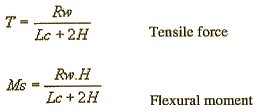The
deck overhang should be designed in accordance to the requirements of the
AASHTO-LRFD article A13.4 to provide a flexural resistance MS, acting
coincident with the tensile force T. At
the inside face of the barrier the deck overhang design forces per foot not
including dead loads may be taken as:

Where:
LC
critical length of yield line failure, ft
H
height of traffic barrier, ft
The
nominal traffic barrier resistance to transverse load, RW, for the
design of deck overhang specified in article A13.4 need not exceed 120% of the
transverse force, Ft, as specified in LRFD Table A13.2-1 based on the
traffic railing test levels.
Background:
The
AASHTO LRFD Specifications article A13.4-2 requires that the flexural capacity
of the deck overhang, MS, exceed the flexural capacity of concrete
barrier at its base, MC. This
means that the deck must have sufficient resistance to force the yield line
failure pattern to remain within the barrier.
The WSDOT traffic barriers are reinforced
based on the FHWA crash testing program oriented toward survival.
This reinforcement requirement produces a traffic barrier system that is
overdesigned, leading to the possibility that the deck overhang is also
overdesigned. In order to prevent
this unnecessary overdesign of the deck overhang, the nominal traffic barrier
resistance to transverse load, RW, transferred from the traffic
barrier to deck overhang need not exceed 120% of the design force required for
traffic barrier design in table A13.2-1.
If
you have any questions regarding these issues, please contact Bijan Khaleghi at
705-7181.
BK
cc: J.
Weigel, 47340
F. Higgins, 47340
